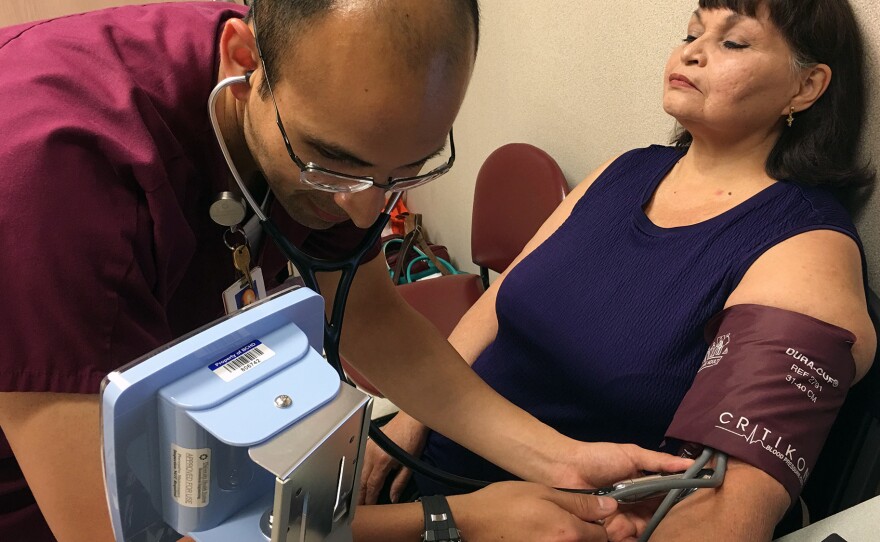You've probably heard the phrase "it takes a village" to get things done. Many clinics across the U.S. are finding that's true for effectively controlling their patients' high blood pressure.
"It's not just medications that are required to treat hypertension," explains Kirk Evoy, a clinical assistant professor at the University of Texas Health Science Center in San Antonio and pharmacist at University Family Health Center Southeast. "It's also things like lifestyle changes," he says. "What do you eat? Do you exercise? Do you smoke?"
A quick prescription and an annual lecture from a doctor aren't always enough to get ahead of this quiet killer, specialists say. Some patients need extra coaching — and from different kinds of coaches.
Take Ann Mazuca, for example. She's 63, has diabetes, is developing glaucoma and really struggles to keep her blood pressure down.
"I know that I have to try to help myself," Mazuca says, but weekly check-ins with the staff at University Family Health Center Southeast help keep her on track in juggling her various conditions. "The fact that they care makes me care," Mazuca says. "People want me to live. And that gives me a lot of hope."
Health care navigator Edlyn Estevez finds she often acts as a health cheerleader at the clinic — providing patients the outside motivation some need. "I want to help them help themselves," Estevez stresses. "I've gotten good feedback, so I feel pretty positive about it."
Pharmacists on the team adjust medications and help people kick their nicotine habit. Physicians help with diet and weight loss. In some similar programs around the country, dietitians help patients choose healthy food options and fitness coaches help with exercise regimens. In San Antonio, free home blood pressure cuffs, bought with a grant from the American Heart Association, have armed patients with a tool for self-monitoring.
Just a couple of years ago, before the team approach was put in place in this San Antonio clinic and its affiliates, more than half the patients had uncontrolled hypertension, according to Dr. Patrick Pierre, a family physician at the clinic. High blood pressure put those patients at risk for kidney damage, heart problems, blindness and stroke.
Today, Pierre says, about 70 percent of his patients have their blood pressure under control.
"To me that was an eye-opener," he says. He credits his team — fellow doctors, nurses medical assistants, even front desk personnel and administrators, as well as patient navigators, pharmacists and the patients — for working together to make it happen.
The investment has also saved money, Pierre says, in terms of inpatient and outpatient medical costs that are linked to high blood pressure. From August to October 2016, for example, 160 new patients were able to control their blood pressure, resulting in a total savings of more than $2 million in inpatient and emergency room visits, according to University Health System.
As part of a national push to embrace this model, the Centers for Disease Control and Prevention and the Centers for Medicare and Medicaid Services co-launched a program called Million Hearts in 2012, aimed at preventing heart attacks and strokes.
The program helps physicians around the U.S. share evidence, best practices and educational materials as research discovers new ways to manage hypertension. Encouraging a multidisciplinary team approach is a major goal.
"This is not an easy thing to tackle," says Dr. Janet Wright, a cardiologist and the executive director of Million Hearts. "The first and most important aspect of controlling hypertension is that everyone in the practice or the practice's network makes this a priority."
Million Hearts offers special recognition to doctors and practices with a 70 percent or higher level of control of their patients' high blood pressure.
"Almost universally, everyone who is a high performer uses a team approach," Wright says.
The team needn't be big to be effective, she adds. Small practices or solo doctors might train a receptionist to be a motivational interviewer or have medical assistants keep in touch with patients between appointments. Often, referral to community resources like walking groups is part of the plan.
About 2,000 patients in three San Antonio clinics have been part of this team approach to treating hypertension, Pierre says.
According to the National Institutes of Health, the collaborative approach is also achieving success in managing other complex illnesses — including diabetes, dementia and lung disease.
Copyright 2017 Texas Public Radio. To see more, visit Texas Public Radio.






